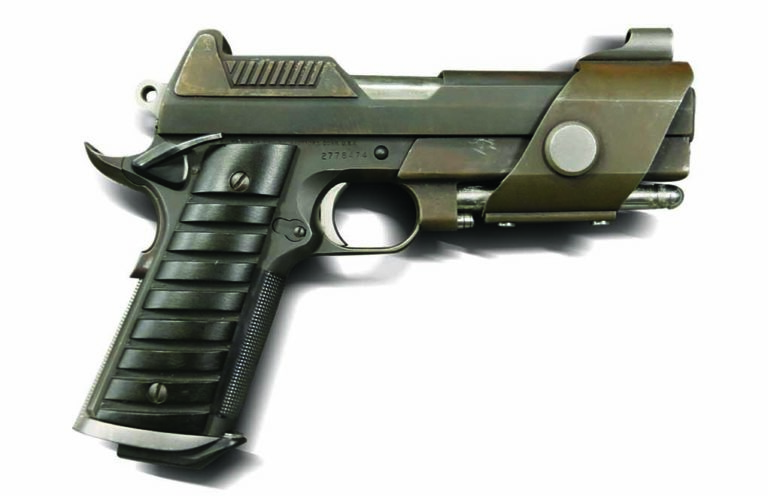
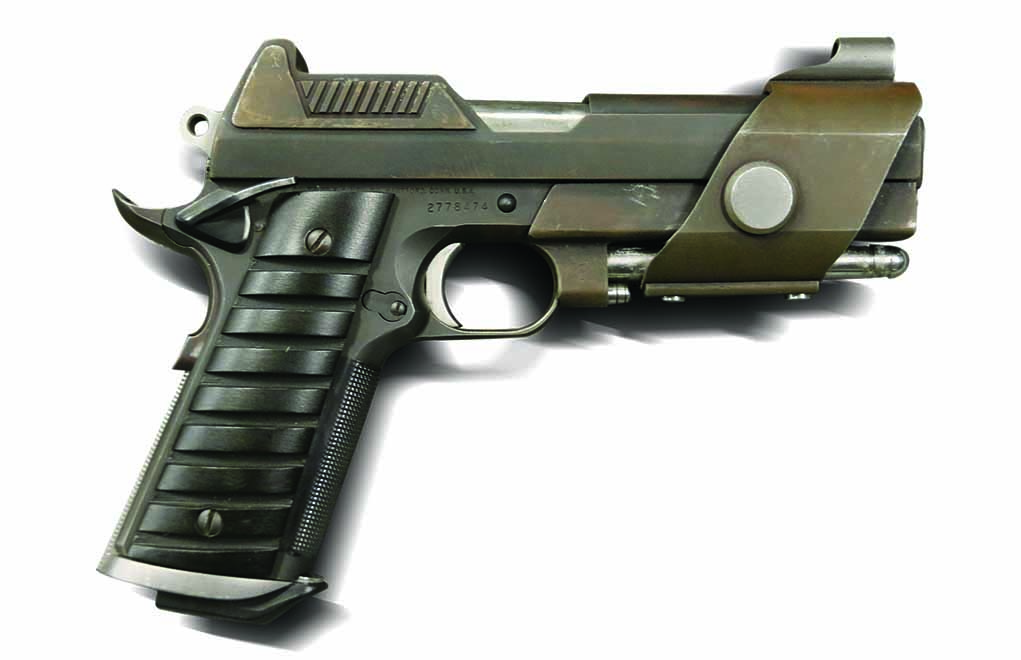
Hollywood 1911 pistols run the complete gamit, from specimens you find at your local gun store to renditions that are out of this world.
For a supposedly obsolete, old firearm, the 1911 is well-represented on the silver screen. It always has been. However, what you see on the screen may or may not be a 1911 or 1911A1. It may also not be a .45 ACP. There are several reasons for that.
OK, let’s set the stage. (See what I did there?) Our hero needs to prevail, and he needs to be properly armed for the climactic shoot-out. But that shoot-out—the part you see on the screen for a minute or even a few seconds—takes months of planning and practice. The director must lay it all out on what are called “storyboards,” which are drawn representations of how they want the camera to see the scene. Then, the producer plans the distances, timing and locations with the location scout and the cinematographer. The producer schedules the practice time, equipment and budget with the prop master.
And that’s where the guns come in. The guns on screen that you see today come in four types: rubber, Airsoft, blank-firing and live. And blank-firing firearms come in four types: quarter, half, three-quarter and full power. Why all these types? Because they need them . It’s just that simple.
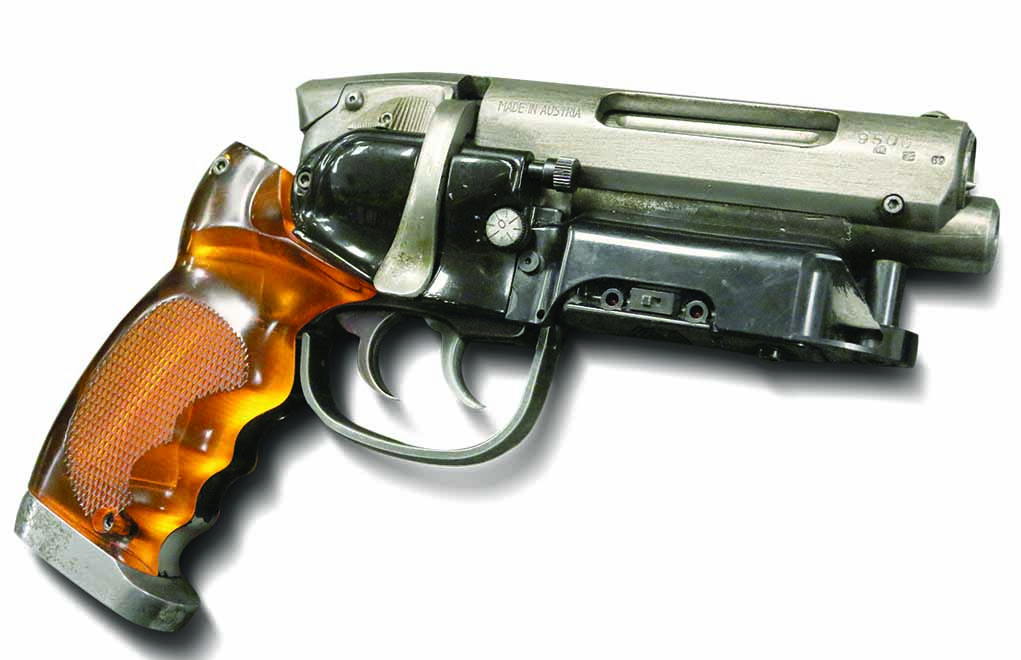
and bet that Gaff wouldn’t chase you?
The rubber guns are for extras who will never use them and to protect the actors (and the guns) from the day-to-day wear and tear of being worn. If you see a squad room scene in a police procedural where everyone is armed, they are all rubber guns. A squad of soldiers who are not actually firing their weapons? All rubber or plastic. In fact, most of the guns you’ll see on the screen and on TV are rubber, plastic or composite dummies, because they are inexpensive; and, compared to real firearms, there is no real paperwork involved.
The molding and casting processes are so high quality that you can read the original serial number of the model used to create the mold. They come in soft rubber (more comfortable, but less durable) and harder compositions. The Airsoft guns allow film crews to work in locations where the noise of blank-firing handguns might be disturbing, such as indoors. The slides cycle, and the computer wizards add in the muzzle flash and flying brass later. There may not even be the little plastic pellets of Airsoft being used. (The sounds are all added in after, regardless of the type of firearm or rubber gun used.) That’s done with CGI.
Blank guns are modified to run with blanks. Despite being so modified and often irreversibly so, they are still firearms and, as such, strictly controlled. Generally, this involves grinding off the locking lugs and putting a plug in the barrel to allow enough gas pressure to cycle the action. The power level represents the power the blanks are loaded to and the power the firearm is built to properly cycle with. A full-power blank gun, being fed quarter-blanks, won’t cycle. A quarter-blank gun being fed full-power blanks can be damaged.
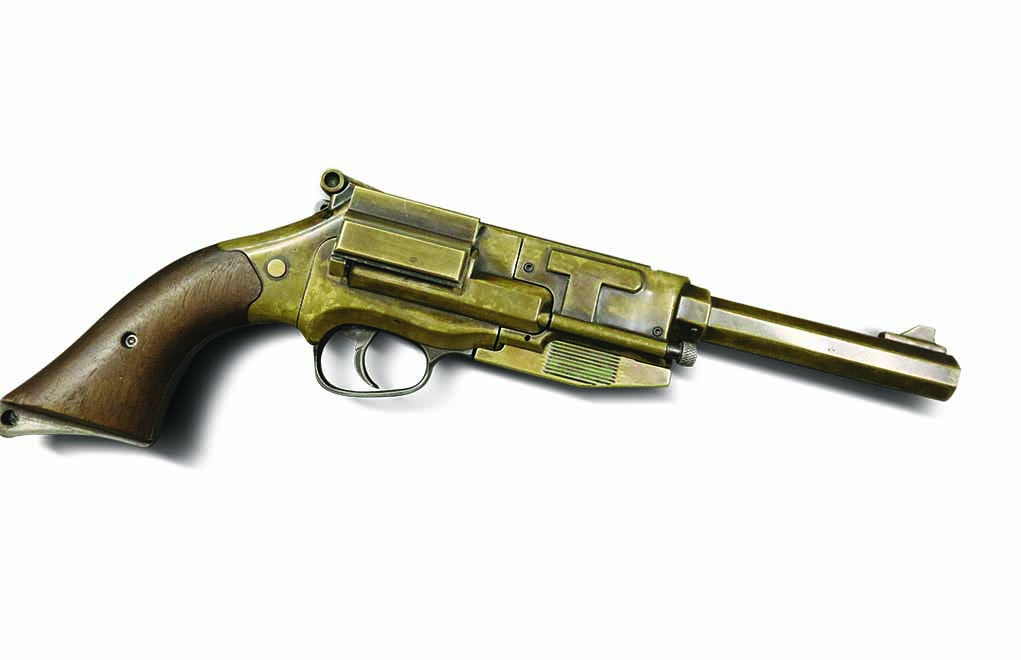
Model B—from the
movie Serenity.
There is also the safety aspect. Blanks can still cause injury or even death. A scene for which the director wants the actors close to each other cannot use full-power blanks. The distance must be calculated and maintained. That’s a big reason for Airsoft and CGI.
Live guns? Sometimes you need live guns for certain scenes, which means you have to acquaint some actors with how they work. Some won’t want to touch these “icky “guns, but some like learning and having fun. And there are those interested in “verisimilitude”—a fancy word meaning “the appearance or semblance of truth.” In other words, it means it’s like the real thing. Also, the sound guys might want to capture the exact report of the firearm being used, just in case. A perfect example of this is in the movie Saving Private Ryan, when the GIs have beaten the German MG42 crew. We hear the machine gun cooling off and the clicks and pops as it settles back down to air temperature. You only get that from the real thing.
And that leads us to another aspect of the prop house: historical accuracy. The prop house is the expert (except for some directors, such as Michael Mann) and makes sure the gear is correct. A Korean War movie with M16s in it is a no-go. A modern police procedural with World War II-era firearms being used better have a good explanation for the viewers, or else they will change channels in disgust. This means prop houses maintain a huge inventory, keep track of the firearms and know what is appropriate, where and when.
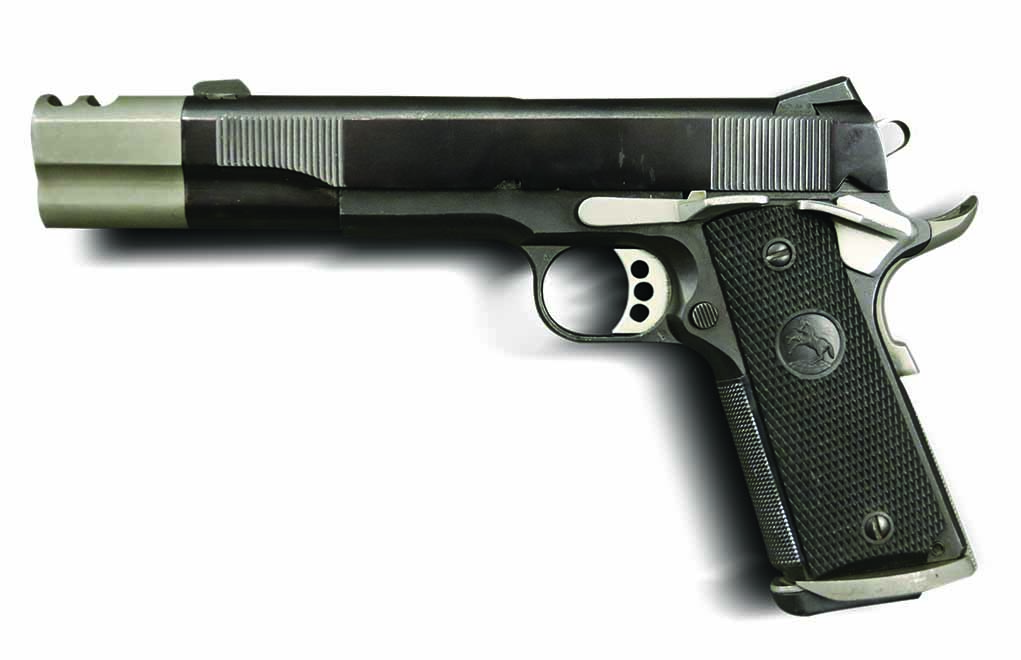
Now, if the director insists on something that is not period-correct, you shake your head, make sure you fulfill the contract and keep that in mind the next time his people call you for the next movie.
Oh, one other part of the firearms experience are the impacts. Called “squibs” in the industry, they are small powder charges that are detonated electrically to show the bullet impact on walls, cars, etc. This can be an incredibly expensive part of a production. You’ve got the actors who will be handed the blank-firing firearms just before the scene starts filming. Then there’s the camera crew, cinematographer, sound man and lighting crew. You can even have two, three or four cameras going at once. You have the prop master and the triggerman for the squibs.
After “lights, camera, action,” the actors start shooting, the squib triggerman sets off the squibs and, if it all goes right, you have a “take.” Then, you set it up and do it again, because the director and editor always want options.

What if the blank gun jams or a blank or squib fail to go off? There are dozens of things that can ruin a take, and when something fails, you set it up and do it all over again.
And finally, there is the legal aspect of things. Not only must the production company keep track of the laws where it is filming — usually the responsibility of the prop master — but it also must know the backgrounds of the actors. (Hmm, how shall I put this? Some actors have lived less-than-stellar lives. In fact, some of them have been convicted of crimes such that they cannot own, or even handle, real firearms. They get rubber guns and CGI.)
Raise Your 1911 IQ:
- Best 1911 Pistol Options For Concealed Carry
- Power On The Cheap: Best Affordable 10mm 1911 Options
- Why The Hell The 9mm 1911?
- Tips For Getting Your Perfect Custom 1911
- 4 Reasons Why The 1911 Pistol Remains On Top
- Thinking Soberly About 1911 Grips
Production companies have gotten themselves into trouble by trying to ship firearms into a country or state in which they’re not permitted or for which they simply haven’t completed the required paperwork. The people involved must know the laws and regulations, have the proper licenses and paperwork, and make sure it is all filled out correctly. I found this out when I visited Independent Studio Services, one of the biggest prop houses. It deals not just with firearms (in fact, firearms are a small part of what it does), and it was head-spinning.

First, anytime there’s going to be a specific firearm on the set of any production, the prop house brings at least two. So, that police procedural with 12 officers walking around? Two dozen rubber guns, at least. Filming an action scene requires at least two blank-firing guns plus rubber clones—for the setup, walk-through and camera framing—and, if the prop master is at all paying attention, other spares of the blank guns of different power levels. Huh?
What if the director suddenly decides that a scene needs to be changed? Instead of a shoot-out in the house of the serial killer, he wants it outside next to the pool, which means you’ll need to switch from quarter-power to full-power blanks, maybe even with extra flash blanks. You’d better have the guns and the ammo on hand, because a production company costs like you wouldn’t believe. Depending on the talents involved, it could be $10,000 an hour, and if the prop master holds things up while a courier drives back to the warehouse to pick stuff up, he will not get hired next time.
And the paperwork? Again, you wouldn’t believe it. OK, let’s say you stage an epic shoot-out with multiple machine guns, squibs for the walls and cars, breaking windows, explosions and more on set somewhere in California. First, the company has to be licensed by both the feds and the state. This includes a standard FFL, an 07 Manufacturers FFL and an ammo manufacturing license (for the blanks). Then, California insists on more licensing for dangerous weapons such as the machine guns, and if explosives are used, that triggers the need for another federal license—plus certification for the training before the licenses will be issued. Then, depending on the firearms that are involved, you might even need to have a transport permit … and dear God, if the local municipality also requires more licensing or paperwork.
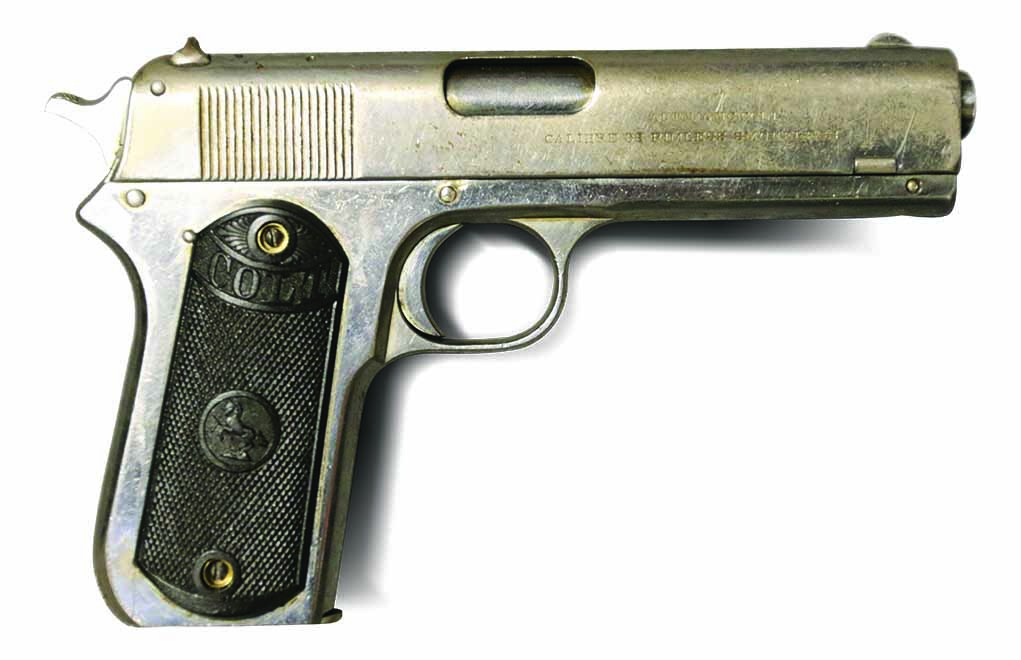
The pistols used might not have been 1911s in the past and often were not .45s. Making 9mm blanks that worked reliably and consistently was a lot easier than doing the same for .45 ACP. As a result, you can see in some movies in the past (if you look closely or use freeze-frame) that the “1911” someone is using is actually a 1903 hammer model or a 1905 or other early Colt pistol.
Later, 1911s that started out as 9mm or .38 Super pistols that had been built as blank-firing guns were used in the movies as .45s. Now, they can be blank-adapted as actual .45s. When I visited Independent Studio Services, I had the opportunity to handle and photograph some famous guns and even shoot some of them. Fun? You have no idea.
Serenity
In the movie Serenity, set in the indeterminate future (supposedly 500 years from now—but, hey, it is a story), the crew of the ship Serenity is working to make a living, shlepping cargo from one plant to another. Despite it being the future, there are a lot of old guns still in use, with some of them upgraded.
Jayne Cobb, the muscle played by Adam Baldwin (no relation to the Baldwin brothers), is very knowledgeable about firearms. His personal 1911 has been worked on and upgraded. What are the upgrades? No idea, but figuring out what would be useful and tactical centuries from now is not the point. I mean, how would you explain a comp on an Open gun to a doughboy?
Rambo
“Rambo” has moved from a movie title reference to a word used in common life as a reference and touchstone. Rambo comes back from Vietnam and, of course, he’d be using a Vietnam-era pistol, which would be a box-stock 1911A1. Except, this one isn’t entirely stock. But, hey, things happen. When Rambo came out in 1982, IPSC was still mostly unknown to Hollywood. The Michael Mann-directed movie, Thief, had just come out the year before.
Sons of Anarchy
“Shakespeare on motorcycles” might describe the TV series Sons of Anarchy. In it, Jax, the son of the club founder, has to take over the reins of power, find his way and stay alive. You would imagine that a series about a motorcycle club would have plenty of opportunities for violence … and you’d be right. Charlie Hunnam (“Jax” ) carries a “blingy” customized 1911A1. The comp on it is a standard stick-a-threaded-barrel-into-a-1911-pistol modification, and the extended slide stop is something that hasn’t been common for almost two decades now. But the rest of it shows attention to proper tools of the trade. And, hey, if the leader of a motorcycle gang wants to carry something, who is going to tell him “no?”
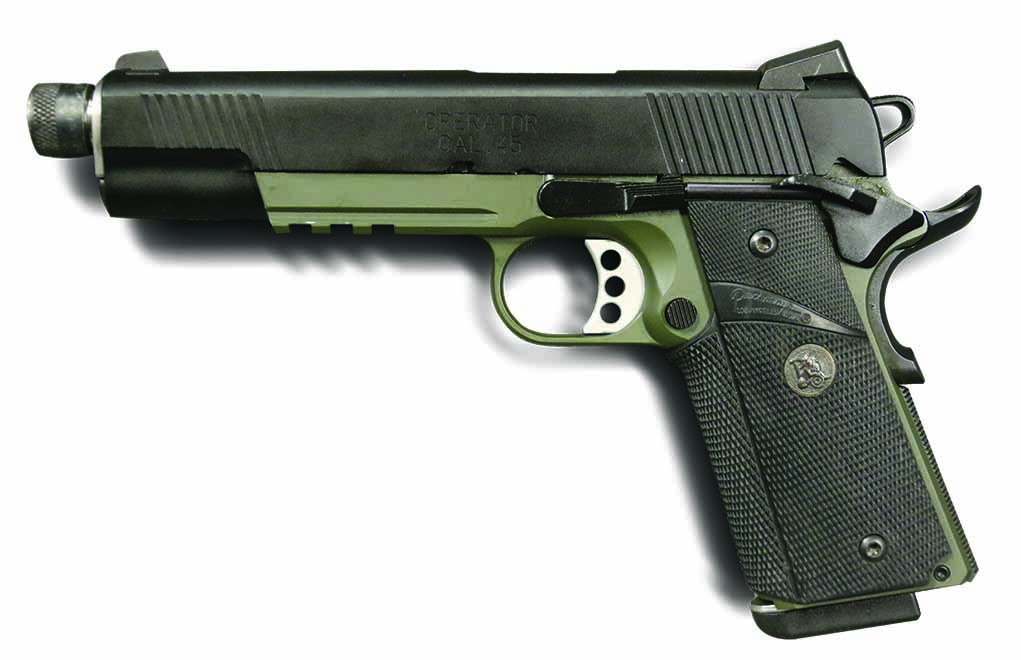
Black Panther
Anyone who does not envy the Marvel crew is not paying attention. Having spent more than half a century building a universe populated with a huge number of characters, it now gets to see it all up on the big screen. In Black Panther, Michael B. Jordan plays Erik Killmonger. That character packs a current-day tool for shooting, a railed and threaded-for-suppressor Springfield Operator, which reflects the character’s Special Operations background. It is hard to argue with it as a choice, either for real-world trials or in the movie setting where it is placed.
Magnum, P.I.
In 1980, Tom Selleck was a tall, handsome guy who had been knocking around Hollywood for a decade, getting parts in TV shows and movies. Nothing big, but he was working. Then came the Hawaiian shirts, Ferraris, helicopters and the 1911A1.
Playing a Navy SEAL (before every wannabe was a SEAL) Vietnam veteran, he was the TV draw for most of its eight seasons and 158 episodes. Men wanted to be him. Women wanted to date him. Everyone dreamt of Hawaii and high-speed car chases.
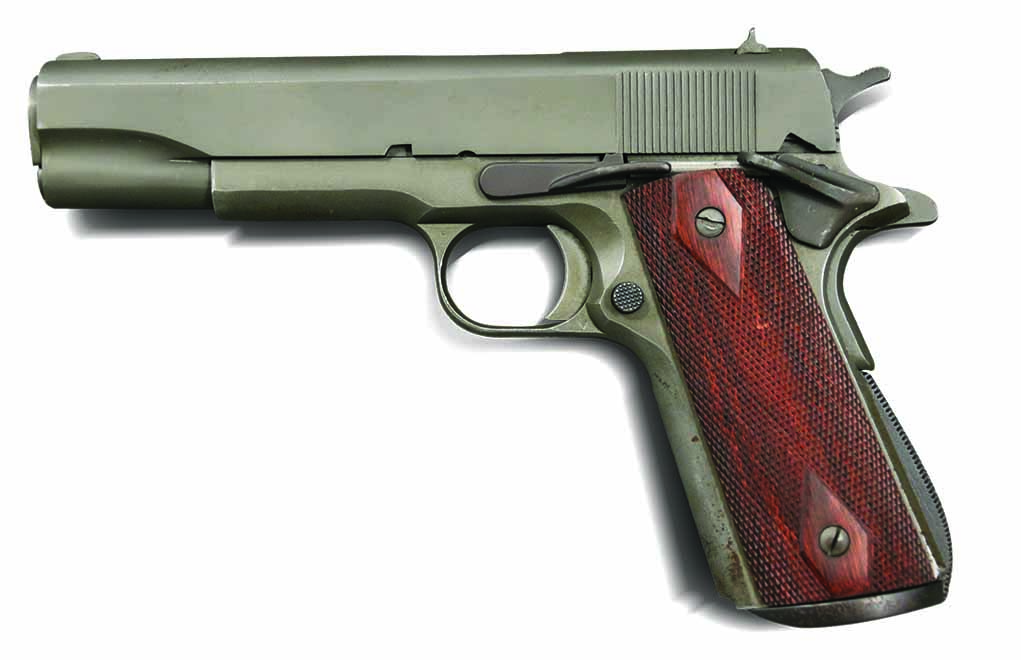
And the 1911 that Mr. Magnum carried? It was a Colt Series 70 chambered in 9mm. It had no changes made to it other than being adapted to blanks. And it fired full-power blanks, which I can attest to, having fired it when I visited. Let me tell you: Full-power blanks, even the 9mm ones, are ferocious. The slide cycle felt like live fire, and the blast and heat from the blanks were everything a live round would be—and more.
I’d have worn a suitable shirt for the test-firing, but the patterns are licensed, and you have to pony up $70 each for the shirts he wore. Maybe I will someday.
SWAT
The first SWAT TV show appeared in 1975. In the time since, the gear carried by SWAT officers has changed. So, if you are doing a movie or TV show and there are SWAT cops involved, the time period represented in its firearms and gear needs to be spot-on.
It is a situation such as this that adds to the inventory of a prop house. You can’t have a realistic show set in the present day if the main characters are using flip phones, driving cars from the muscle-car era and shooting it out with gangster-era firearms. Viewers are going to notice.
So, prop houses and producers work hard to make things period correct. That leads to multiple generations of SWAT gear, among other props, to ensure viewers can keep track of when it aired.
Editor's Note: This article is an excerpt from Patrick Sweeney’s book, “1911, The First 100 Years, 2nd edition.” For a deeper look into the must-have resource for any 1911 owner, go to GunDigestStore.com.

Next Step: Get your FREE Printable Target Pack
Enhance your shooting precision with our 62 MOA Targets, perfect for rifles and handguns. Crafted in collaboration with Storm Tactical for accuracy and versatility.
Subscribe to the Gun Digest email newsletter and get your downloadable target pack sent straight to your inbox. Stay updated with the latest firearms info in the industry.

![Best Concealed Carry Guns In 2025 [Field Tested] Wilson Combat EDC X9S 1](https://gundigest.com/wp-content/uploads/Wilson-Combat-EDC-X9S-1-324x160.jpg)


![Best 9mm Carbine: Affordable PCCs [Tested] Ruger Carbine Shooting](https://gundigest.com/wp-content/uploads/Ruger-Carbine-Shooting-100x70.jpg)
![Best AR-15: Top Options Available Today [Field Tested] Harrington and Richardson PSA XM177E2 feature](https://gundigest.com/wp-content/uploads/Harrington-and-Richardson-PSA-XM177E2-feature-100x70.jpg)

What, no long slide AMT .45 with full length laser sight?! How could you forget the Terminator’s gun?